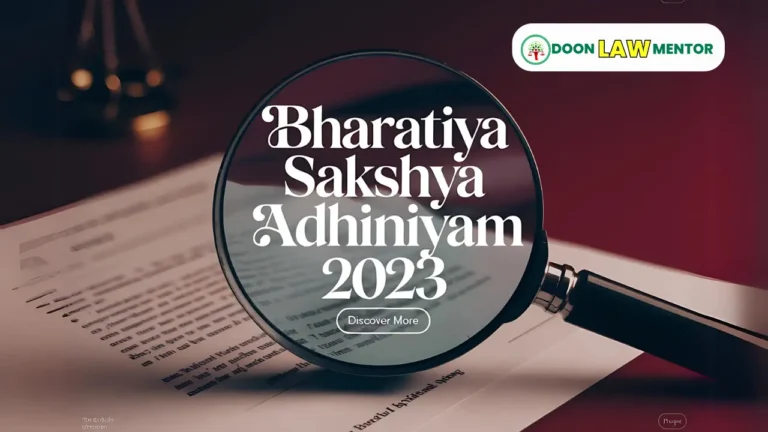The Uttarakhand Judicial Services 2025 exam faces a Supreme Court challenge for excluding blind and non-domiciled PwBD candidates. Learn about the case, legal issues, and implications for UKPCSJ 2025 aspirants. Prepare with Doon Law Mentor.
Table of Contents
Introduction
What happens when a judicial exam excludes people with disabilities? The Uttarakhand Judicial Services 2025 exam is under fire for this reason. In Sravya Sindhuri v. Uttarakhand Public Service Commission and Ors. (2025 SC), the Supreme Court is reviewing this issue. The case challenges the exclusion of blind, visually impaired, and non-domiciled candidates from the Persons with Benchmark Disabilities (PwBD) quota. For UKPCSJ 2025, this case is crucial. It involves key constitutional and statutory provisions. This guide explains the Uttarakhand Judicial Services 2025 challenge in simple terms. We analyze the legal issues, landmark judgments, and provisions in detail. With Doon Law Mentor’s support, you’ll understand this case and its exam relevance.
read More: Unclogging the Docket: Supreme Court’s Innovative Approach to Case Pendency
Background of the Uttarakhand Judicial Services 2025
The Uttarakhand Judicial Services 2025 exam recruits Civil Judges (Junior Division). The Uttarakhand Public Service Commission (UKPSC) issued the exam notification on May 16, 2025. It announced eight vacancies, with specific reservations for PwBD candidates. The selection process includes three stages: Preliminary Exam, Mains Exam, and Viva-Voce. Candidates need a Bachelor of Laws (LL.B.) degree, proficiency in Hindi (Devanagari script), and basic computer knowledge. The age limit is 22–35 years, with relaxations for reserved categories. However, the notification sparked controversy. It limited PwBD reservations to specific disabilities: leprosy cured, acid attack victims, and muscular dystrophy. This excluded candidates with blindness, low vision, or locomotor disabilities. It also restricted non-domiciled PwBD candidates. These limits led to the Supreme Court challenge.
read More: RPSC APO Mains 2025: 1st June Exam Details, Admit Card, Timings and Instructions
The Case: Sravya Sindhuri v. Uttarakhand Public Service Commission
The Supreme Court heard Sravya Sindhuri v. Uttarakhand Public Service Commission and Ors. on June 9, 2025. The petitioner, Sravya Sindhuri, has 100% visual impairment. She challenged the Uttarakhand Judicial Services 2025 notification. The case was before Justices SVN Bhatti and PB Varale. The petitioner argued that the notification violates the Rights of Persons with Disabilities Act, 2016 (RPwD Act). It also denies her request for a scribe during exams. The Uttarakhand Judicial Services 2025 notification limits PwBD eligibility to three disability types. It also excludes non-domiciled PwBD candidates. The petitioner claims this violates constitutional rights and prior court rulings.
Legal Issues in the Challenge
The Uttarakhand Judicial Services 2025 notification faces three main challenges. First, it violates Articles 14, 19(1)(g), and 21 of the Constitution. Article 14 ensures equality before the law. Excluding blind and locomotor disability candidates is arbitrary. Article 19(1)(g) protects the right to practice a profession. The restriction denies this right to PwBD candidates. Article 21 guarantees the right to life with dignity, which includes fair access to opportunities. Second, the notification breaches Section 34 of the RPwD Act, 2016. This section mandates 4% reservation for PwBD in government posts. It includes 1% for blindness and low vision and 1% for locomotor disabilities, among others. Limiting PwBD reservations to three subtypes ignores this law. Third, the Uttarakhand Judicial Services 2025 notification contradicts a prior Supreme Court ruling. In Re: Recruitment of Visually Impaired in Judicial Services (2023), the Court allowed visually impaired candidates in judicial services.
read More: Can the Supreme Court Refuse Presidential Questions : Article 143 Explained?
Detailed Analysis: Constitutional Provisions
The Uttarakhand Judicial Services 2025 challenge rests on key constitutional provisions. Article 14 guarantees equality before the law and equal protection. The notification’s exclusion of blind and locomotor disability candidates creates unequal treatment. It lacks a reasonable basis, making it arbitrary. The Supreme Court has held that classifications must be rational (State of West Bengal v. Anwar Ali Sarkar, 1952 AIR 75). The Uttarakhand Judicial Services 2025 restriction fails this test. Article 19(1)(g) protects the right to practice a profession. Excluding qualified PwBD candidates from judicial roles violates this right. The Supreme Court in State of Maharashtra v. Chandrabhan Tale (1983 AIR 803) emphasized that restrictions on this right must be reasonable. The domicile requirement for PwBD candidates is not justified. Article 21 includes the right to livelihood and dignity. Denying PwBD candidates fair access to the Uttarakhand Judicial Services 2025 exam undermines this right. The Court in Olga Tellis v. Bombay Municipal Corporation (1985 AIR 180) linked livelihood to dignity. These provisions form the legal backbone of the challenge.
Detailed Analysis: Rights of Persons with Disabilities Act, 2016
Section 34 of the RPwD Act, 2016 is central to the Uttarakhand Judicial Services 2025 case. It mandates that every government establishment reserve 4% of vacancies for PwBD. This includes 1% for blindness and low vision, 1% for locomotor disabilities (including cerebral palsy, leprosy cured, dwarfism, acid attack victims, and muscular dystrophy), 1% for hearing impairments, and 1% for other disabilities like autism. The Uttarakhand Judicial Services 2025 notification limits PwBD reservations to leprosy cured, acid attack victims, and muscular dystrophy. This excludes blindness, low vision, and locomotor disabilities, violating Section 34(1)(a) and 34(1)(c). The Supreme Court in Vikash Kumar v. UPSC (2021 SCC OnLine SC 84) ruled that PwBD candidates are entitled to reasonable accommodations, like scribes. The Uttarakhand Judicial Services 2025 notification’s failure to provide a scribe breaches this mandate. The Act also prohibits discrimination based on disability, reinforcing the petitioner’s claim.
Analysis: Re: Recruitment of Visually Impaired in Judicial Services
The Uttarakhand Judicial Services 2025 challenge draws heavily from Re: Recruitment of Visually Impaired in Judicial Services v. Registrar General, High Court of Madhya Pradesh (2023, Suo Motu WP (Civil) No. 2 of 2024). In this case, the Supreme Court, led by Justices JB Pardiwala and R Mahadevan, struck down a Madhya Pradesh Judicial Services Rule. The rule barred visually impaired and low-vision candidates from judicial service. The Court held that such exclusions violate Section 34 of the RPwD Act. It also affirmed that visually impaired candidates are eligible for judicial roles. The judgment emphasized reasonable accommodation, like scribes or assistive technology. The Uttarakhand Judicial Services 2025 notification mirrors this issue. Its exclusion of blind candidates contradicts the Supreme Court’s ruling. The petitioner cited this case to argue that the Uttarakhand Judicial Services 2025 rules are unconstitutional. The Court’s directive for states to comply with this judgment strengthens the petitioner’s case.
Case Study: Sravya Sindhuri’s Plea
Sravya Sindhuri, a visually impaired lawyer, challenged the Uttarakhand Judicial Services 2025 notification. She has 100% visual impairment and applied under the unreserved category. Her plea, argued by counsel Amar Jain, seeks to quash the notification dated May 16, 2025. The Uttarakhand Judicial Services 2025 notification excludes blind and locomotor disability candidates from the PwBD quota. It also denies non-domiciled PwBD candidates eligibility. Sindhuri argued that these restrictions violate Articles 14, 19(1)(g), and 21. She also highlighted the lack of a scribe for exams, breaching Section 20 of the RPwD Act, which mandates reasonable accommodations. Initially, the Supreme Court bench (Justices SVN Bhatti and PB Varale) asked her to approach the Uttarakhand High Court. However, citing the pending Re: Recruitment of Visually Impaired case, the bench agreed to refer the matter to the Chief Justice of India (CJI) for tagging with the suo motu case. This case highlights the Uttarakhand Judicial Services 2025’s failure to ensure inclusivity.
Reliefs Sought by the Petitioner
The petitioner seeks five reliefs against the Uttarakhand Public Service Commission, Uttarakhand High Court, and State of Uttarakhand:
- Quash the Uttarakhand Judicial Services 2025 notification for preventing non-domiciled PwBD candidates from applying, violating the RPwD Act.
- Quash the notification for limiting PwBD eligibility to leprosy cured, acid attack victims, and muscular dystrophy.
- Direct the UKPSC to revise the Uttarakhand Judicial Services 2025 notification to include all PwBD categories and non-domiciled candidates.
- Order the Uttarakhand High Court to comply with the Re: Recruitment of Visually Impaired judgment and file a compliance report.
- Instruct the State of Uttarakhand to identify posts suitable for PwBD, per Section 34, RPwD Rules, and reasonable accommodation principles. These reliefs aim to make the Uttarakhand Judicial Services 2025 inclusive and lawful.
Table: Key Legal Provisions in the Challenge
| Provision | Description | Violation in Uttarakhand Judicial Services 2025 |
|---|---|---|
| Article 14 | Equality before the law | Excludes blind and locomotor disability candidates arbitrarily. |
| Article 19(1)(g) | Right to practice a profession | Denies PwBD candidates judicial roles. |
| Article 21 | Right to life with dignity | Restricts fair access to opportunities. |
| Section 34, RPwD Act, 2016 | 4% reservation for PwBD in government posts | Limits PwBD quota to three disability types. |
| Section 20, RPwD Act, 2016 | Reasonable accommodations for PwBD | Fails to provide scribes for exams. |
This table, created by Doon Law Mentor, summarizes the legal issues in the Uttarakhand Judicial Services 2025 challenge. It’s useful for exam notes.
Implications for Judicial Services
The Uttarakhand Judicial Services 2025 challenge has wide implications. If the Supreme Court rules in favor of the petitioner, the notification may be revised. This would allow blind, visually impaired, and locomotor disability candidates to apply. Non-domiciled PwBD candidates could also participate. The ruling could set a precedent for other states. It would reinforce Section 34 of the RPwD Act and the Re: Recruitment of Visually Impaired judgment. The Uttarakhand Judicial Services 2025 exam could become a model for inclusivity. It would ensure reasonable accommodations like scribes and assistive technology. This aligns with Article 41 of the Constitution, which directs the state to secure opportunities for disabled persons. The case also highlights the Supreme Court’s role in protecting constitutional rights.
Challenges in Implementing Inclusive Policies
The Uttarakhand Judicial Services 2025 case exposes challenges in inclusive policies. First, state commissions may misinterpret RPwD Act provisions. The UKPSC’s limited PwBD categories show this gap. Second, domicile-based restrictions create unequal access. The Supreme Court in Dr. Jaishree Laxmanrao Patil v. Chief Minister (2021 SCC OnLine SC 362) struck down domicile-based reservations as discriminatory. Third, providing reasonable accommodations like scribes requires resources and training. The Uttarakhand Judicial Services 2025 notification’s failure to address this violates Section 20 of the RPwD Act. These challenges require clear guidelines and compliance with court rulings.
Future of Disability Inclusion in Judicial Services
The Uttarakhand Judicial Services 2025 case could shape disability inclusion. A favorable ruling would push states to align with the RPwD Act. It would ensure all PwBD categories are included in judicial exams. The Supreme Court’s suo motu case on visually impaired candidates shows a broader commitment. States may need to adopt assistive technologies, like screen readers, for exams. Training exam staff on reasonable accommodations will be key. The Uttarakhand Judicial Services 2025 challenge could lead to nationwide reforms. It would make judicial services accessible to all qualified candidates.
Conclusion
The Uttarakhand Judicial Services 2025 challenge in Sravya Sindhuri v. Uttarakhand Public Service Commission is a landmark case. It questions the exclusion of blind and non-domiciled PwBD candidates. The Supreme Court is reviewing violations of Articles 14, 19(1)(g), and 21 and the RPwD Act. For MPCJ, DJS, and CLAT aspirants, this case is vital. It covers constitutional law, disability rights, and judicial powers. The ruling could make the Uttarakhand Judicial Services 2025 inclusive. Lawyers and students must understand these issues. Join Doon Law Mentor at doonlawmentor.com for expert resources and mock tests. Start your legal journey now!
FAQs
What is the Uttarakhand Judicial Services 2025 case about?
The Uttarakhand Judicial Services 2025 case challenges the exclusion of blind and non-domiciled PwBD candidates from the exam.
Why is the notification challenged?
It limits PwBD reservations to three disability types and excludes non-domiciled candidates, violating the RPwD Act.
Which constitutional articles are cited?
Articles 14 (equality), 19(1)(g) (profession), and 21 (life with dignity) are cited.
What is Section 34 of the RPwD Act?
It mandates 4% reservation for PwBD, including blindness and locomotor disabilities.
What reliefs are sought?
Quashing the Uttarakhand Judicial Services 2025 notification and revising it for inclusivity.
How does the Supreme Court’s prior ruling apply?
The Re: Recruitment of Visually Impaired case allows visually impaired candidates in judicial services.
What is reasonable accommodation?
It includes scribes and assistive technology for PwBD candidates, as per the RPwD Act.
#UttarakhandJudicialServices2025, #SupremeCourt, #DisabilityRights, #RPwDAct, #JudicialExams, #ConstitutionalLaw, #PwBDInclusion, #DoonLawMentor, #LegalEducation, #SupremeCourtCases










